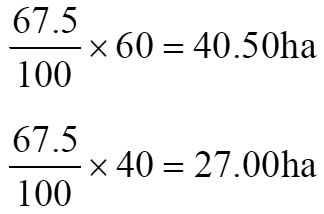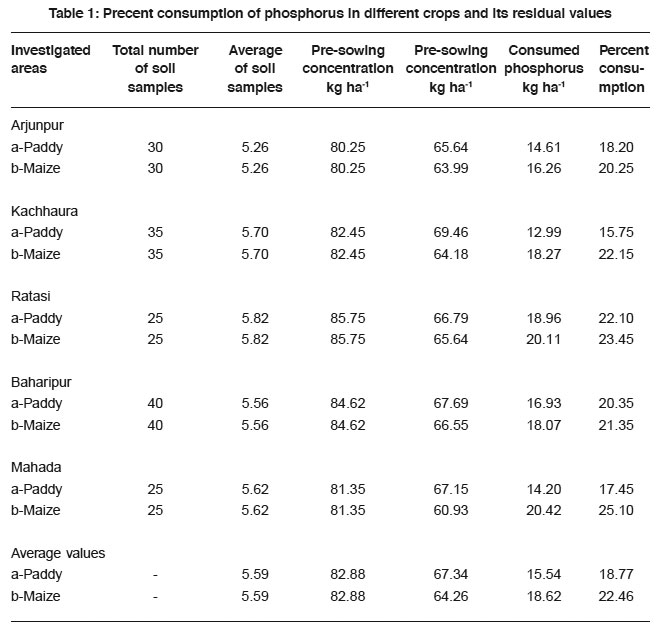Consumption coefficient of phosphorus by some crops in the solids of Jaunpur District (U.P.) India
Ashok Kumar Singh1 * , M. H. Ansari1 , S. K. Singh2 and N. P. Singh3
1
Department of Chemistry,
S.G.R.P.G. College,
Dobhi,
Jaunpur,
Uttar Pradesh
India
2
Department of Chemistry,
U.P. Autonomous College,
Varanasi,
Uttar Pradesh
India
3
Department of Chemistry,
T.D.P.G. College,
Jaunpur,
Uttar Pradesh
India
DOI: http://dx.doi.org/10.12944/CWE.3.1.16
Through the intenstive use of fetilizers green revolution has been successful increasing agricultural production bu the spot of ground where the corn and plants grew has changed beyond recognition. In the race of producing more food at any cost, soils in countries like India has badly deteriorated. Industrialization, urbanization and infrastructural developments have reduced agricultural land to a significant extent which is to be compensated by excesive use of fertilizers. Crops according to their nature consume a fraction of nutrients applied to the field while the rest causes soil and water pollution. In the present investigation an attempt has been made to assess the consumption coefficient of phosphorus by two common crops. i.e. mzie (Zea mays) and paddy (Oryza sativa).
Copy the following to cite this article:
Singh A.K, Ansari M.H, Singh S.K, Singh N.P. Consumption coefficient of phosphorus by some crops in the soils of Jaunpur District (U.P.) India. Curr World Environ 2008;3(1):119-122 DOI:http://dx.doi.org/10.12944/CWE.3.1.16
Copy the following to cite this URL:
Singh A.K, Ansari M.H, Singh S.K, Singh N.P. Consumption coefficient of phosphorus by some crops in the soils of Jaunpur District (U.P.) India. Curr World Environ 2008;3(1):119-122. Available from: http://www.cwejournal.org/?p=777
Download article (pdf) Citation Manager Publish History
Select type of program for download
| Endnote EndNote format (Mac & Win) | |
| Reference Manager Ris format (Win only) | |
| Procite Ris format (Win only) | |
| Medlars Format | |
| RefWorks Format RefWorks format (Mac & Win) | |
| BibTex Format BibTex format (Mac & Win) |
Article Publishing History
| Received: | 2008-03-12 |
|---|---|
| Accepted: | 2008-05-17 |
Introduction
Fertilizers are the organic or inorganic materials of natural or synthetic origin which are added to the soil to supply certain elements essential to the growth of plants. In order to supply the nutrients in a readily available from to the plants, fertilizers and manures are used. Nitrogen, phosphorus and potassium are required by the plants in large amounts and are therefore designated as major or primary nutrients. In phosphate fertilizers, phosphorus is present in the form of phosphate or superphosphate salt and is available to the plants when it is combined with organic matter or with Ca or Mg. Phosphorus has often been called "master key to agriculture" as low crop production is due more often to a lack of phosphorous¹ than to the deficiency of any other element except nitrogen. It is also found in combination with Fe and AI is present in certain rock minerals as apatite. Plants takeup phosphorus chiefly as PO4----, HPO4--- and H2PO4- ions and availability of these ions depend chiefly upon the acidic of the ground. They become nearly insoluble in strongly acidic or strongly acidic or strongly alkaline soils. The breakdown of phosphatic fertilizers produces phosphoric acid in soluble form that is absorbed by plant. Different crops intake phosphorus consumed by the crops is designated by 'consumption coefficient' which depends upon the mode of assimilation of nutrients by the plant. Phosphorus plays an important role in energy transformation and participates in fat and protein metabolism. The most obvious effect2-4 of phosphorus is on the root system of plants. It promotes and participates in lateral and fibrous roots which increases the absorbing surface for nutrients. It is essential for seed formation. Phosphorus gives strength to the straw and helps to prevent lodging. Phosphorus increases disease resistance in plants, presumably due to normal cell development and resulting vigorous growth. Leguminous crops grown under phosphate deficiency conditions may suffer from nitrogen deficiency as well, since the nodule bacteria function normally only when plants are supplied with adequate phosphorus. Each organic and inorganic forms of phosphorus occur in soil and both are important to plant as sources of this element5-6. Over application hastens ripening but may so reduce the length of the growing period as to reduce productivity.
Keeping in view the unbalanced use of fertilizers and also creating awareness among the farmers, the present work was undertaken for making better soil conditions for farming and to reduce pollution as low as possible.
Material and Methods
The areas under study comprise Badlapur tahsil of Jaunpur district (U.P.). The soil of the experimental site is almost sandy clay. The average pH of the soil is 5.59 showing the acidic character of soil. The Olsen's method7 was taken in practice for the assessment of residual phosphorus content of the soil on adding phosphatic fertilizer before sowing and after harvesting the crop.
Results
Calculations
The average area of each village under conditions is 27 hectare. Hence total area covered by all these five villages will be = 27×5=5=135ha. About 50% of the total area is covered by gardens, house, barrel land and other cultivated crops and remaining 50% is cultivated by paddy and maize. Hence, 135/2 = 67.5 ha.
Among the total area about 60% area is cultivated by paddy and 40% by Maize.
Hence

Now, since 67.34kg/ha phosphorous remains unconsumed by paddy and 64.26 kg/ha by maize. Hence, total unconsumed phosphorus by paddy crop cultivated over 40.50ha = 67.34 × 40.50 = 2727.67 kg.
Similarly total unconsumed phosphorus by maize crop.
Cultivated over 27.0 ha = 64.26 × 27.0 = 1735.02kg Grand total = 2727.67+1735.02 = 4462.69kg
Hence, unconsumed phosphorus/ha = 4462.69/67.5 = 66.12 kg/ha.
 |
Table 1: Precent consumption of phosphorus in different crops and its residual values Click here to view table |
Discussion
Data is Table 1 reveal that in Arjunpur, Kachhaura, Ratasi, Baharipur and Mahada villages the percentage of phosphorus consumed by paddy and maize are 18.20, 15.75. 22.10, 20.35, 17.45 and 20.25, 22.18, 23.45, 21.35, 25.10 respectively. The average percent consumption of these nutrients per hectare area found to be 18.77 and 22.46kg separately. Thus through these two crops only the average percent contribution of phosphorus to the soil becomes 79.38 kg ha-1, which is significantly large and may lead to a high degree of pollution in soil, water, grain and fodder.
Besides the positive effects of fertilizers use, the negative aspects which are often overlooked must be addressed with special attention to the environmental issues8. Thus, mineral and organic fertilizers are often accused of leading to the accumulation of dangerous or even toxic substances is soil from fertilizers constituents e.g. Cd from mineral phosphatic fertilizer in ground water, adversely affects the quality of drinking water, as unwanted enrichment of the atmosphere with ammonia from organic manures and mineral fertilizers and with N2O from identification of excessive or wrongly placed fertilizer, thereby contributing to global warming.
As far as the biodiversity is concerned, inefficient use, overuse and abuse of fertilizers cause considerable ecological loss to the nation and the farmer. Thus, among the farmers if adequate awareness is not developed, there will be extravagance on one hand and terrible pollution hike on the other hand causing health hazards to the poor villages. It is also remarkable that small scale farming contributes larger share of phosphorus pollution of India the small scale farming will dominate upon the large scale farming evolving a greater prospects of pollution leading the situation from bad to worse
Acknowledgements
The authors are highly thankful to the Principal, S.G.R.P.G. College, Dobhi, Jaunpur (U.P.) for providing necessary facilities. Authors owe a lot to agriculture extension department of U.P. (India) for providing experimental facilities and relevant documents.
References
1. Tamhane, R.V., Motiramani, D.P., Bali, Y.P. and Donahue, L. Soils, Their chemsitry and fertilityy in tropical asica. Ist Edn., (1965) 305.
2. Zhao Quing and Zeng Dehui, Acta Phytoecologia Sinica., (2005)29: 153.
3. Ochwoh, V.A., Classens, A.S. and Jager, P.C.De., Communications in soil science and plant analysis., (2005) 36: 535.
4. Mondal, A.K., Jalali, V.K., Navneet Pareek and Pradeep Wali., J. Ind. Soci. Soil Sci., (2004) 52: 467.
5. Guppy, C.N., Menzies, N.W., Moddy, P.W. and Blamey, F.P.C., Aust. J. Soil. Res., (2005) 43: 189.
6. Kudeyarow, V.N. and Semenov, V.N., Pochvovedenie., (2004) 12: 1440.
7. Chopra, S.L. and Kanwar, J.S., Anal. Agri. Chem., IVth Edn. (1991) 230.
8. Sanyal, S.K. and Chatterjee, S., Ind. J. Fert. (2007)3: 87.







